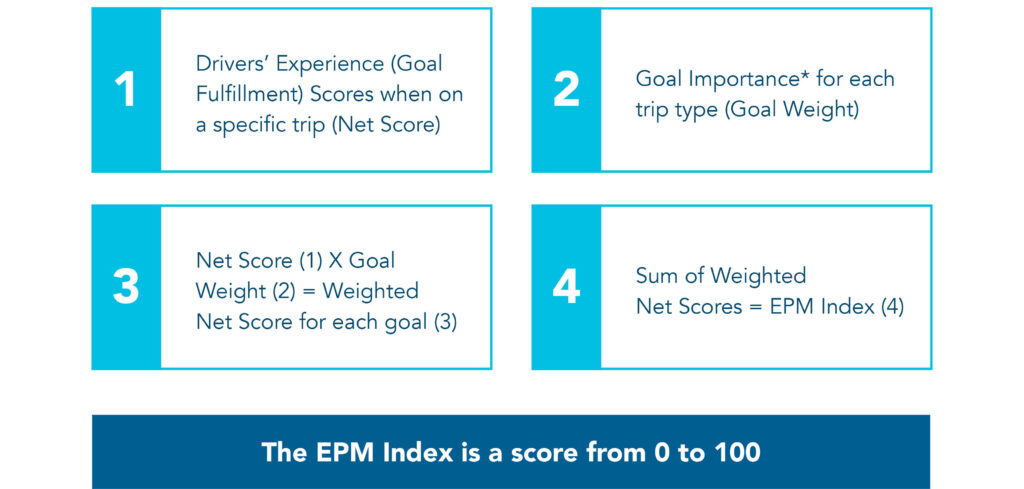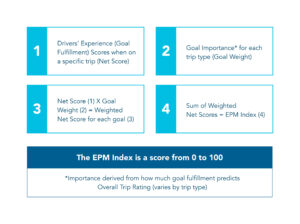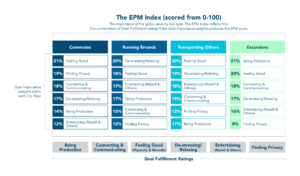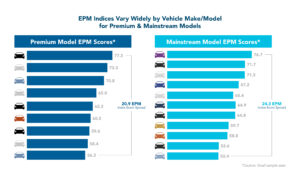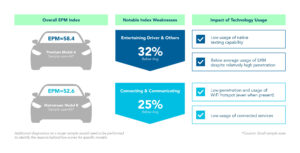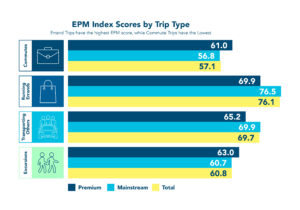The Experiences Per Mile (EPM) Advisory Council has released an experience-based metric for the automotive industry. The metric – designed for use by the automotive industry – will score vehicles on their ability to provide end users with positive and fulfilling in-vehicle experiences.
Unlike traditional measures of mechanical performance, the latest Automotive EPM Index can be used by consumers to help them make more informed buying decisions. It can also help OEMs tailor vehicle offerings to suit specific user requirements.
The EPM Index scores vehicles from 0-100 based on a user’s experience goals for different journeys and trip types. The metric is based on research conducted by IPSOS, in which users scored vehicles on how well their individual goals for a particular journey were achieved. This net score is multiplied by the importance, or weighting, that goal has for the trip type. The sum of the weighted scores then equates to the vehicle’s EPM Index.
The new metric focuses on the in-cabin experience goals of connecting, being productive, feeling good, de-stressing/relaxing, entertaining and finding privacy. Trip types consist of commuting, running errands, excursions and giving rides. The eventual aim is that every new vehicle will receive an Automotive EPM Index rating to enable easy comparison of individual vehicles based on their ability to meet the in-cabin goals associated with particular journey types.
For example, a vehicle may have a high Automotive EPM Index rating for excursions and school runs, making it suitable for use as a family car. Alternatively, a vehicle with a high score for commuting would suit users who cover many business miles.
The EPM Advisory Council – an independent entity fostering cross-industry innovation – developed the metric in collaboration with GM, Harman, HERE Technologies, Hyundai, SBD Automotive, Stellantis and TomTom.
“We are seeing this shift as part of an evolution from the old world of RPMs and other traditional criteria to a world where experiences are the key value proposition,” said Tom Rivers, vice president, of global automotive marketing at Harman, and a founding member of the EPM Advisory Council. “Where consumers once asked, ‘How fast can I go from 0 to 60?’, they now want to know, ‘How can this vehicle improve my commute?’, or ‘Can I access the content/info/people important to me during my time in the car?’ And, as the electrification and autonomous trends advance, it makes sense that the focus on experiences in the vehicle as opposed to what powers it will grow.”
Rivers added, “There has been no established rating to measure the in-vehicle experience, so this way of thinking about experiences as a true value-add is new territory. There are several OEMs represented on the EPM Advisory Council and they have been heavily involved in the process of shaping the EPM Index, indicating that they see value in this measurement to help build their brand with new generations of consumers. From what we are seeing, the OEMs fully realize the need to shift emphasis from individual features and functions to more holistic experiences in order to meet their customers where they are and give them what they demand from their vehicles.”


